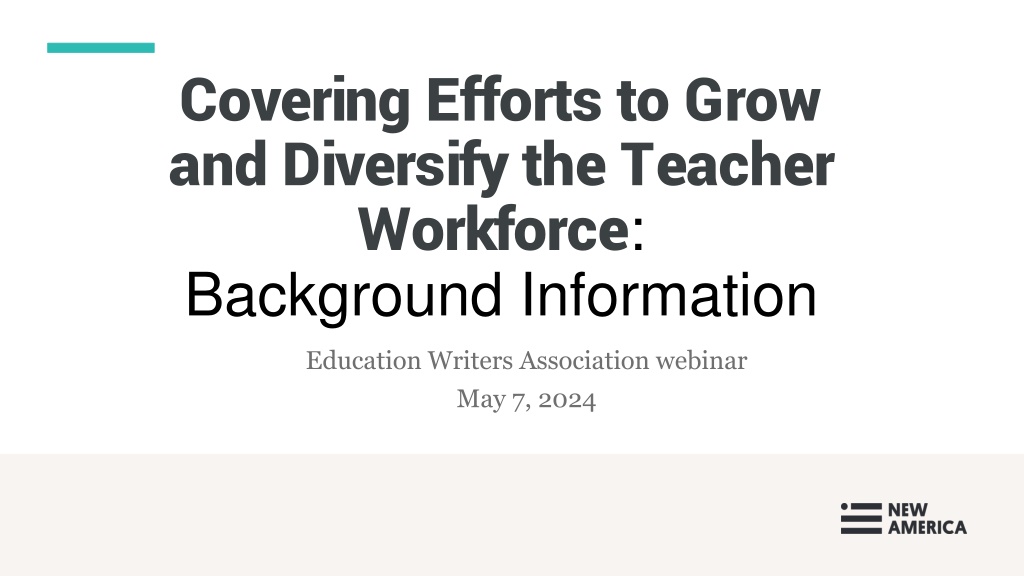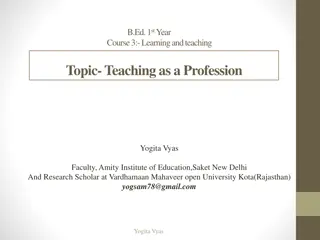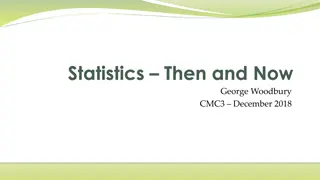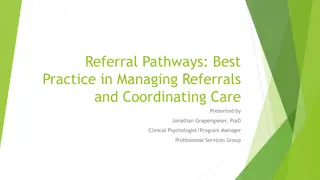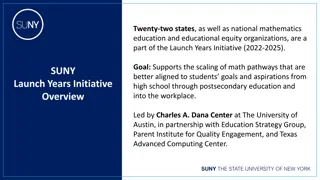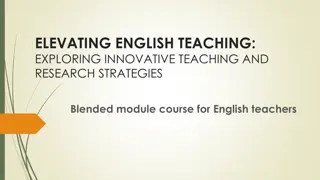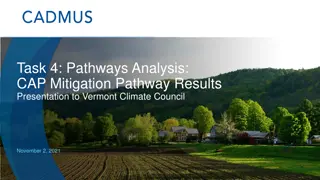Diversifying Pathways into Teaching: Insights and Strategies
Exploring efforts to enhance the teacher workforce diversity and quality, this article delves into the complexities of addressing teacher shortages and provides insights from a national database on the various state pathways into teaching. Discover the diverse approaches taken by different states and the key findings that shed light on the availability and variability of teacher training pathways across the country.
Download Presentation

Please find below an Image/Link to download the presentation.
The content on the website is provided AS IS for your information and personal use only. It may not be sold, licensed, or shared on other websites without obtaining consent from the author. Download presentation by click this link. If you encounter any issues during the download, it is possible that the publisher has removed the file from their server.
E N D
Presentation Transcript
Covering Efforts to Grow and Diversify the Teacher Workforce: Background Information Education Writers Association webinar May 7, 2024
Teacher Shortages: NotJust about Quantity Some efforts to increase teacher quantity in the short term actually inhibit a robust, talented, diverse workforce in the long term. Teacher Workforce Quantity
Rephrasing the Teacher Shortage Question How can we shore up the supply, quality, and diversityof the teacher workforce in both the near and long term to meet the needs of every student?
National Scan of Pathways into Teaching In 2023, New America developed a comprehensive database of all state pathways to becoming a full-time teacher of record in a public school for the first time. Looking at interplay between teacher preparation and teacher credentialing requirements. Preparation (If Any) First Time Pathway Into Teaching Initial Credential https://www.newamerica.org/education-policy/reports/national-scan-of- pathways-to-becoming-a-first-time-teacher/
Whats Captured in the National Database of Pathways into Teaching? Details each of the 358 available state pathways attributes, including: Recruitment targets (candidate characteristics, school type, and/or subject matter) Required pre-service activities, knowledge and/or skills, and the tools used to assess that a teacher candidate has them Initial teaching credential type earned and its validity period Requirements to remain and/or progress as a teacher, if any https://www.newamerica.org/education-policy/reports/national-scan-of- pathways-to-becoming-a-first-time-teacher/
National Scan of State Pathways into Teaching: Key Findings
A Pathway for Nearly Every Day of the Year Nationally, nearly 360 distinct pathways to a first-time, full-time teaching role exist. The number of pathways each state makes available varies widely, from a low of three (District of Columbia) to a high of 12 (Arkansas, Kentucky, Louisiana, and South Carolina). States most commonly offer between five and eight distinct pathways.
Varied Coherence & Clarity Statewide In many states, challenging to identify the pathways to becoming a first-time teacher, how they compare, and which someone would qualify for. BUT: Some states label pathways in ways that reflect the preparation method and/or recruitment objective, which improves clarity about who might qualify, and how. Other states have developed user-friendly resources for relaying this information (e.g., HI, MN, UT). Only a few states pathways holistically fit together, illustrating a clear overall vision and strategy for meeting teacher staffing goals.
Focused on Boosting Short-Term Supply Many state policies seem designed to increase quantity, without focus on quality or diversity. Best strategies to increase supply: Only remove (or make optional) requirements with little evidence of connection to teaching ability. Target individuals with expertise in high-demand subjects or in locations with outsized staffing need. Target teachers of color with high-quality preparation approaches (i.e., with strong clinical preparation) to shore up retention, as well as recruitment, of a more diverse workforce.
Identified Five Core Categories of Pathways 1)Full Initial (33%) Includes traditional prep For those who complete preparation prior to beginning teaching 1)Interim (32%) Typically for those beginning to teach prior to formal preparation 1)Targeted (15%) Recruits individuals with relevant knowledge and/or experience in a specific area of instructional need 1)Last Mile (8%) For those lacking one specific full initial requirement (typically passing a credentialing test or completing a training) 1)Emergency (11%)
Fewer Credential Types than Pathways In most states, a given teaching credential can be obtained via more than one pathway, so pathways out-number credential types. Concerning that some states allow pathways with requirements of very different rigor to lead to an identical first-time teaching credential.
Varied Opportunities for Continuing to Teach How long an individual with a specific set of requirements can teach on their first-time credential varies widely by state. Some states offer clear paths to becoming fully licensed for emergency credentialed teachers, while others do not, resulting in more turnover. Some approaches to retaining under-prepared teachers draw on evidence for promoting educator quality (IN, MI, MN, WA), while others do not.
State Approaches to Strengthen Pathways into Teaching
Actions to Strengthen Pathways into Teaching Action Type Develop Lower Lift *Consult research on how pathway design may impact the landscape of teacher quality, diversity, and quantity in the short and long term. Heavier Lift *Redesign the system of pathways into teaching to coherently reflect state and local priorities in attracting a robust, high-quality, and diverse workforce. *Group similar types of preparation approaches together into discrete pathways and outline minimum requirements. *Provide incentives for pursuing the pathway(s) into teaching most likely to positively influence quality and retention.
Actions to Strengthen Pathways into Teaching Action Type Lower Lift Communicate *Eliminate jargon. Heavier Lift *Offer prospective teachers a tool with details on the preparation, requirements, and validity period for initial AND progressive credential for each pathway to help identify best match(es). *Make pathway preparation type, requirements, and outcomes easy to find online, and date resources. *Communicate any incentives for pursuing pathways most likely to positively influence teaching ability and retention. *Create visual aids to help illustrate the options for becoming a teacher.
Actions to Strengthen Pathways into Teaching Action Type Lower Lift Track *Track and publish data on candidate demographics and credential progression for each pathway. Heavier Lift *Design systems that integrate data from state PreK 12 education, higher education, and workforce agencies to track and publish data on the hiring, retention, and performance of candidates from each pathway.
Actions to Strengthen Pathways into Teaching Action Type Lower Lift Analyze *Analyze data on the demographics and credential progression for each pathway and use them to inform modifications to the overarching system of pathways. Heavier Lift *Analyze data on the hiring, retention, and performance for each pathway and use it to inform modifications to the overarching system of pathways.
Clarifying Terminology on Types of Teacher Preparation Programs
Clarifying Terminology on Types of Teacher Preparation Programs Traditional Attain baccalaureate degree with education focus (major or minor, depending on state), and complete clinical training requirement (aka student-teaching ). Alternative Catch-all for any preparation that is not traditional approach. Includes a wide array of requirements, rigor, and providers (e.g., higher education institutions, nonprofits, and/or school districts). Historically all post-baccalaureate programs, but shifting with recent addition of registered apprenticeship.
Grow Your Own (GYO), Residency, & Registered Apprenticeship Teacher Preparation Programs -Similarities and Differences- https://www.newamerica.org/education-policy/edcentral/whats-the-difference- between-gyo-teacher-residency-and-teacher-registered-apprenticeship/
GYO, Residencies, & Registered Apprenticeships -Similarities and Differences-
